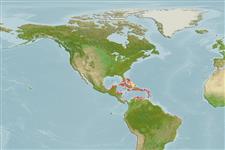Common names from other countries
Environment: milieu / climate zone / depth range / distribution range
Écologie
; profondeur 0 - 1 m (Ref. 83435). Tropical
Distribution
Pays | Zones FAO | Écosystèmes | Occurrences | Introductions
Western Central Atlantic.
Length at first maturity / Taille / Poids / Âge
Maturity: Lm ? range ? - ? cm Max length : 10.0 cm TL mâle / non sexé; (Ref. 289)
Maximum depth from Ref. 110502. Epibiotic (Ref. 110502). Intertidal; very common on open shore (Ref. 289); common in the zone between tides in the rocky coast, mainly on rocks of arenaceous; adheres with great force to rocks (Ref. 292); intertidal, spray zones of rocky shores (Ref. 2022, page 122).
Life cycle and mating behavior
Maturité | Reproduction | Frai | Œufs | Fécondité | Larves
Members of the class Polyplacophora are mostly gonochoric. Life cycle: Eggs hatch into lecitotrophic planktonic trocophore larvae (no veliger stage) which later metamorphose and settle on the bottom as young adults.
Burghardt, G. and L. Burghardt. 2006. (Ref. 281)
Statut dans la liste rouge de l'IUCN (Ref. 130435)
statut CITES (Ref. 108899)
Not Evaluated
Not Evaluated
Utilisations par l'homme
| FishSource |
Outils
Plus d'informations
Taille/ÂgeCroissanceLongueur-poidsLongueur-longueurMorphologieLarvesAbondance
Sources Internet
Estimates based on models
Preferred temperature
(Ref.
115969): 26.3 - 28.4, mean 27.3 (based on 199 cells).
Vulnérabilité
Low vulnerability (10 of 100).
Catégorie de prix
Unknown.
